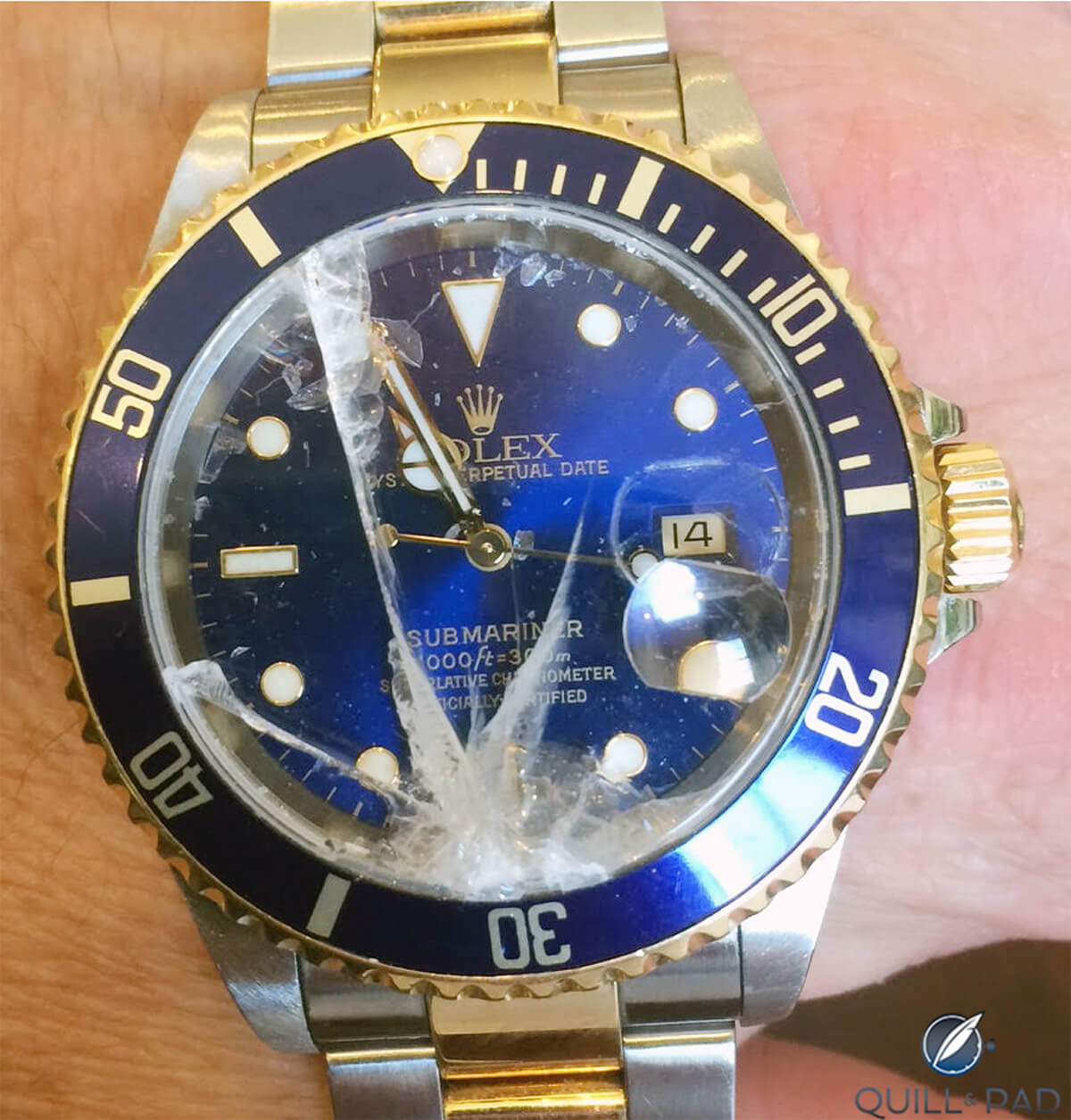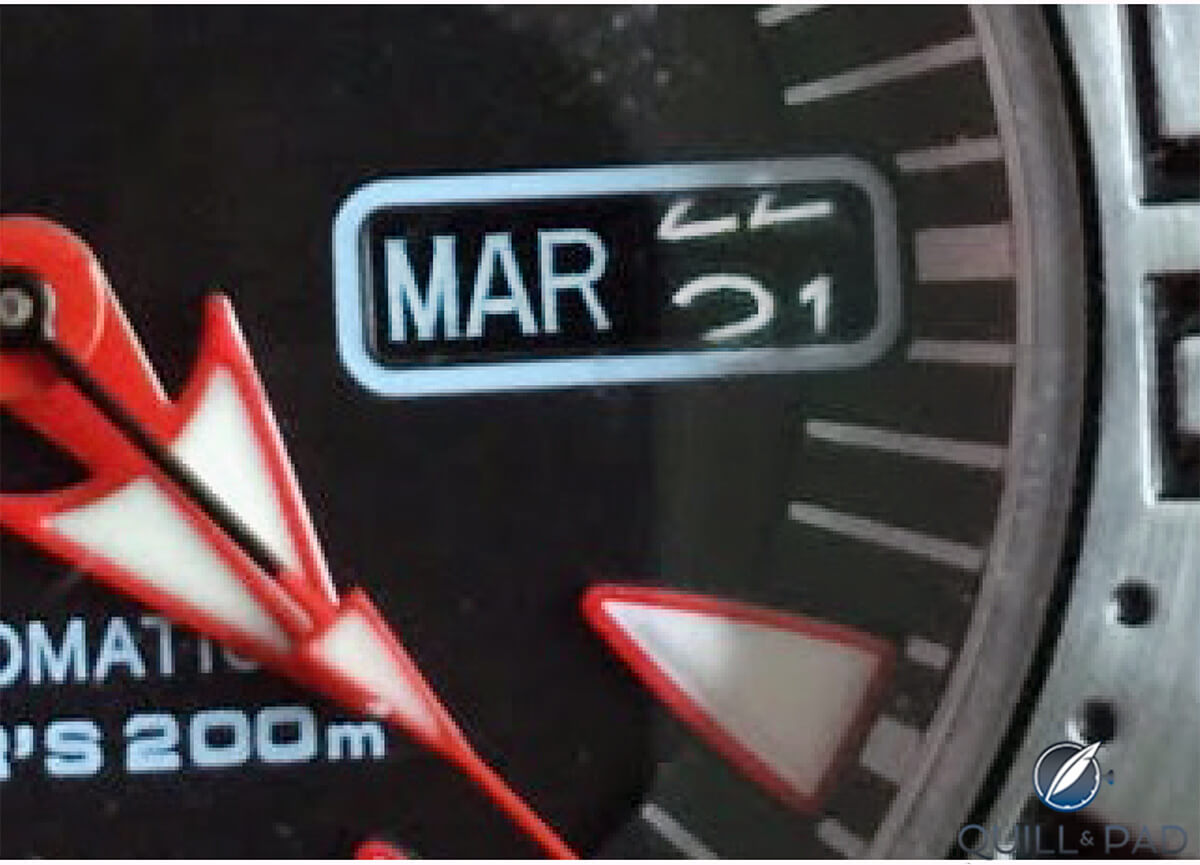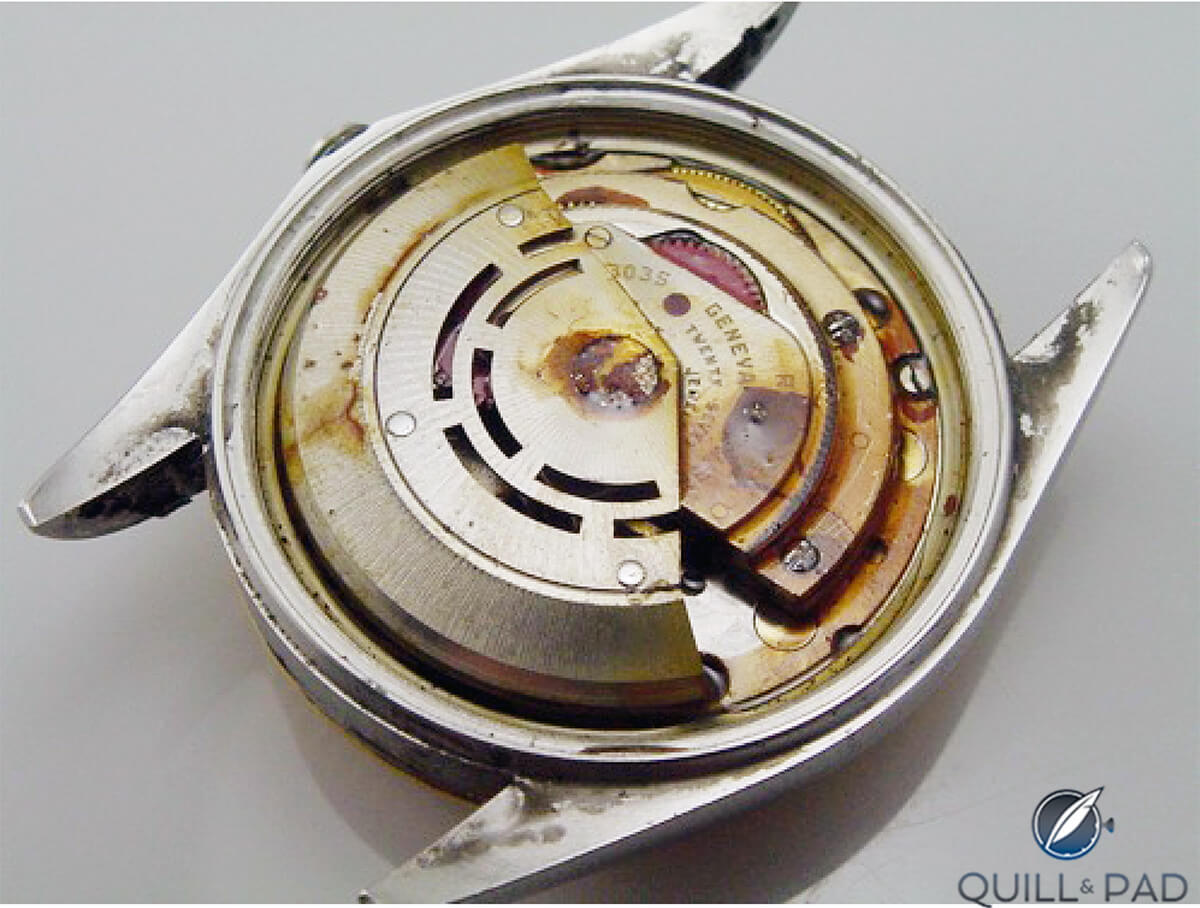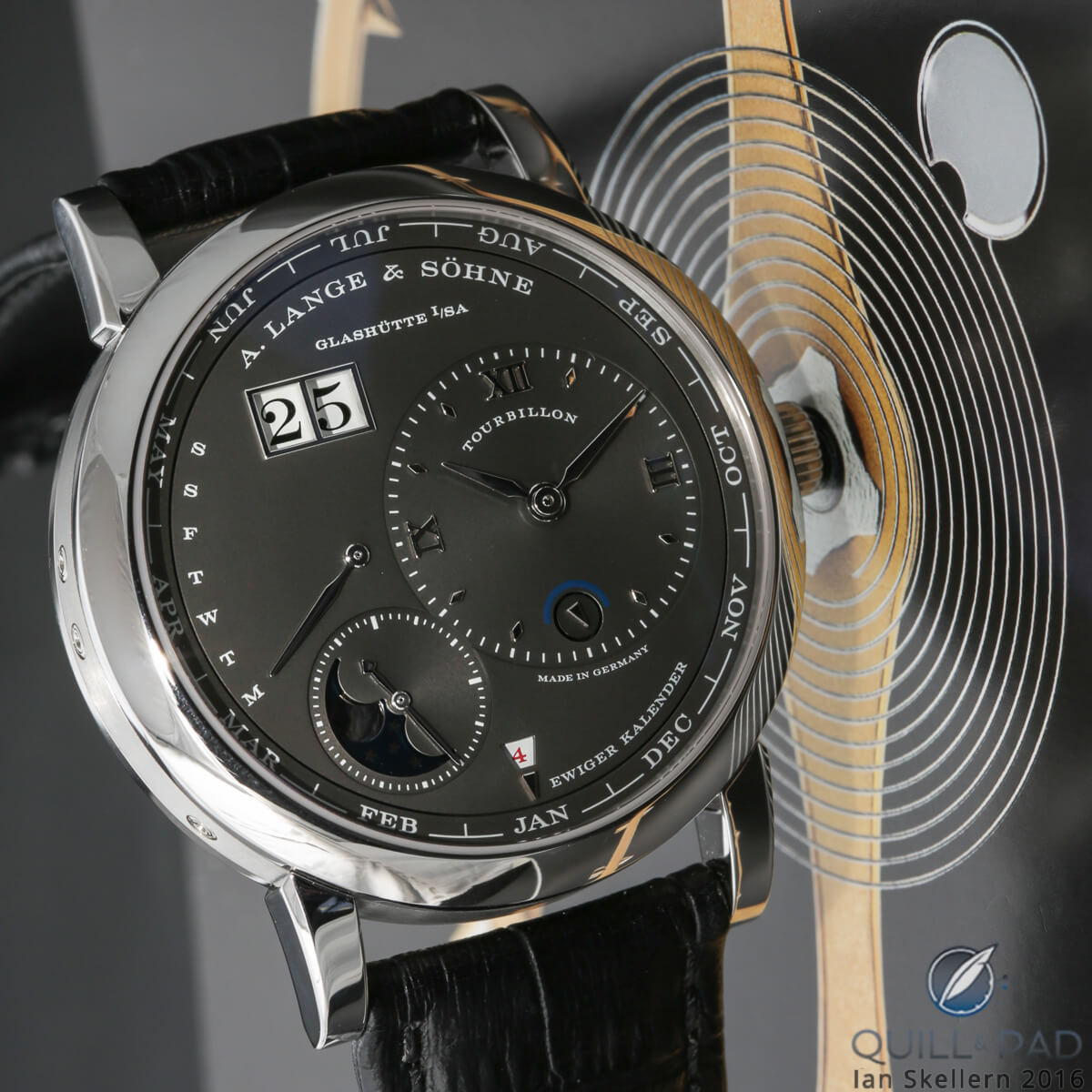5 Unexpected Ways You Might Damage A Mechanical Watch
by John Keil
Timepiece repairs can be expensive and often take a long time, which is why you would want to avoid damaging a watch.
For most people it’s obvious that throwing your watch against a wall, running over it with a Bentley, or smashing it with a hammer are things to to avoid.

Ouchhh! This Rolex Submariner has seen better times
However, not everything that can damage a watch is so obvious, so here I list five common things you may not be aware of that can damage a watch and how to prevent them.
Adjusting the date, day, or other complication/function at the wrong time
When you spend a lot of money on a fine timepiece, the last thing you want to do is to have to pay a small (or large) fortune repairing it simply because you did not take time to read the instruction manual.
You should not make adjustments – such as setting the date or day of the week – when the time on the watch reads between the hours of 9:00 pm and 3:00 am.

Setting the indications around midnight can cause misalignment
Each movement has its own guidelines so this may vary a little, but avoiding setting anything a few hours either side of midnight should keep you out of trouble.
The reason is fairly simple: although a date, the weekday, etc. makes its changeover close to midnight, the gears that make that change happen to engage quite a bit earlier. And it takes extra time to disengage completely in the aftermath.
Result: The most common result is misalignment of the date in the window and there could also possibly be broken components floating around in the movement.
Prevention: A simple rule of thumb when making adjustments is to bring the hour hand to the lower half of the dial, maybe 5:00, 6:00, or 7:00, prior to adjusting the complication. This will ensure that you are out of the “Danger Zone” (queue the cheesy Kenny Loggins song from Top Gun).
Refer to the instruction manual to know what the “safe” times of any specific watch are.
Cross threading the crown while screwing back into the case
A screw-down crown on a watch, common on diving and sports watches, helps to maintain the added depth rating by keeping the stem snugly secure in the sealing gasket. After winding or setting a watch with a screw-down crown, it is necessary to screw the crown back in correctly. This ensures proper water integrity.
Result: If the crown is slightly out of alignment when you screw it back in, the threads of the tube and crown may cross and cause permanent damage.
Prevention: Simply take your time screwing the crown back in! A crown should rotate at least 1.5 full turns, but only up to three full turns, while being screwed in. If the crown seems to stop very quickly (under one full turn), do not force it. In fact never force anything on a watch.
Back down, unscrew fully, and attempt again.
The winding stem is not sealed by screwing in (that’s the job of the rubber seal), a screw-down crown just minimizes the risk of the stem moving in the seal while under water.
Keep in mind, you do not ever have to torque your crown down too tightly – just until it stops is fine. It is possible to screw it down so tightly that it can be all but impossible to unscrew.
Each watch has its own personality, and until you become comfortable with any particular piece, don’t push it. Get to know your watch.
Using a chronograph while the watch is submerged
Some may ask, “Why would anyone use a chronograph under water?” I may answer, “You can’t believe the things people do.”
And while this is rare, I did have a client once who came in with a badly water-damaged watch. When I asked how this happened, he told me that he was on vacation and he and his kids were timing how long they could stay under water. I guess the watch lost!
Result: Most chronographs are water-resistant to at least some degree. The chronograph pushers hold water at bay with no problem in their normal positions, however when a pusher is pushed into the case it can compromise the seal and allow water to enter, causing major water damage.

Rust on a watch movement is is not a pretty sight (image courtesy Gevril Group)
Because parts of a watch movement are small and metal they can quickly rust and dials and hands can discolor. This can be a very pricey repair, while in some cases it can “total” the watch, leaving the repair cost higher than the residual value of the whole timepiece.
Prevention: Do not use your chronograph while under water!
In addition, some watches have screw-down chronograph pushers. If your watch has these, be sure that they are screwed in.
Not pushing the recessed pushers in all of the way
Recessed pushers are not very common and many watch collectors are not even aware they exist. But they most definitely exist on many complicated and expensive timepieces such as perpetual calendars.
Essentially, these flush-to-the-case pushers control adjustments of complications such as the date, day, month, leap year, and moon phase, etc. On the Martin Braun Eos Boreas, for example, they also control the adjustment of the sunrise and sunset indications as well as the equation of time.

A. Lange & Söhne Lange 1 Tourbillon Perpetual Calendar with small recessed pushers set into the case band
Brands selling watches with recessed pushers generally deliver a stylus or push pin with them. Using the stylus, pressing the pusher all the way in and letting it come back all the way out will advance the watch by one day for example.
Result: If the pusher is half-heartedly pushed in before it is let back out it can cause complications to get stuck in the middle of where they should be (between the 7th and 8th on a date, say). Sometimes this can be quickly corrected by advancing the watch a full 24 hours by rotating the hands, but in some cases it must go in for a costly repair.
Prevention: Take your time. Push the recessed pusher all the way in and let it all of the way out.
Magnetization
When I was a kid, I remember sticking a paperclip to a magnet, then taking that paperclip off the magnet and sticking it to the refrigerator.
Like that paperclip, small metal parts in a watch movement may become magnetized. If you rest your watch on a stereo speaker with a large magnet inside of it or even an iPhone, the magnetic fields can transfer to the parts of a movement.
Watches usually start gaining or losing many seconds or minutes a day when the balance is magnetized. A good way to test if your watch has been magnetized is to wave it slowly and closely under a compass. If the compass hand moves as a result, your watch is magnetized.
If you’re really out of luck, though, you won’t even have to do that because the result will provide the answer.
Result: When this happens, it can cause the escapement of the watch to act very erratically or in rare cases seize up. This causes an erratic rate and as a result large discrepancies in the time display.
Prevention: Be mindful of where you put your watch. Clock radios, stereo speakers, iPads, and other electronic devices with magnets in them should be kept away from your watch wherever possible.
Disclaimer: no timepieces were harmed in the making of this post.
What’s the craziest way you have damaged a watch? Let us know in the comments below.
* This article was first published on June 20, 2016 at 5 Unexpected Ways You Might Damage A Mechanical Watch. You may find a few of the comments under that article interesting.
You may also enjoy:
Why You Can’t Afford To Buy Your Watch If You Can’t Afford To Break It
Zen And The Art Of Wristwatch Maintenance: The Benefits Of Learning To Service Your Own Watch
Leave a Reply
Want to join the discussion?Feel free to contribute!



“What’s the craziest way you have damaged a watch? Let us know in the comments below.”
1) Playing “air drums” 😃
2) A child once deliberately stabbed my watch
with a pen. Fortunately it didn’t have an acrylic
crystal.
3) I have one watch which I am convinced keeps
trying to commit suicide. It seems to
intentionally strike every hard object within a 1m
radius of my wrist!
Oh well, the fact that now I have a nice collection and I am able to service all my own watches by myself is due to one of these errors 🙂 Back in 2013 I bought a knock-off Cartier (actually a terrible fantasy fake) in Istanbul Grand Bazaar and, being it the first mechanical watch I ever owned and the fact that it had zero “box and papers”, I had no clue about the risks involved into date change at certain times… And I managed to break the stem while trying to change the date at 22.30…
Being a strong DIYer I started to research on how to fix it (it was an open heart DG2813 cheap Chinese movement), and here I am now, 9 years later, after much studying and practice (with few initial disasters) with a proper bench, my quite vast set of tools, around 50 mechanical watches (Breitling/Panerai/Rolex/IWC/Omega among the others) and quite well trained into watch service and repair (yeah, I can’t still fix mangled hairsprings or rebuild entire gears… That’s a bit to much for me).
Not all the bad things have a bad ending 🙂
Not had any disasters myself, but you might want to take that photo of a clearly fake Rolex watch off the start of the article before the famous Swiss maker notices.
from review on Glashutte SeaQChronometer on Monochrome.
stanislaw witold zolczynski
asks :The quesions is, can chrono pushers be operated under water?
says:
bruce goulard answer :stanislaw – yes!